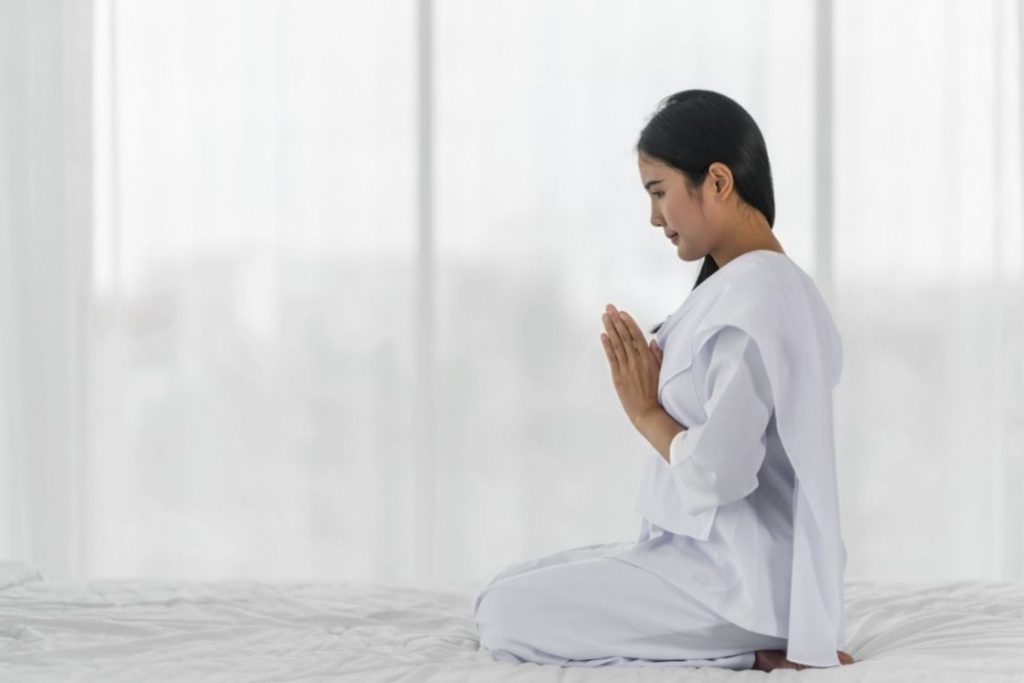
Japa is a Sanskrit word that means “to utter in a low voice” or “to repeat internally.” It is the practice of silently or softly repeating a mantra, affirmation, or sacred phrase during meditation to focus the mind and deepen awareness.
Japa meditation is typically done while sitting in a comfortable meditative position. A Japa mala (a string of 108 beads) is used in the right hand to keep track of each repetition, gently rolling one bead at a time toward you after chanting the mantra.
At the heart of Japa practice is the mantra itself. The word mantra comes from manas (mind) and tra (tool or instrument), meaning a “tool for the mind.” A mantra is a sacred sound, syllable, phrase, or verse that helps bring the mind to stillness and supports deep meditation.
Mantras can range from single syllables like bija mantras (Om, Hreem, Shreem) to longer verses from spiritual texts or positive affirmations. When repeated with focused attention and devotion, mantras carry powerful vibrational energy that can calm the mind, uplift the spirit, and transform your inner state.
Mantras for Japa meditation
In Japa meditation, mantras are repeated to calm the mind and connect with deeper awareness. These can be simple sounds like Om, devotional phrases like Om Namah Shivaya, or powerful Sanskrit verses such as the Gayatri Mantra.
Traditionally, practitioners use a Guru mantra a mantra given by a spiritual teacher. However, you can also choose your own, based on your intention and what resonates most with you.
To help you begin, here is a list of commonly used and powerful mantras that are ideal for Japa meditation.
1. OM Japa
It goes without saying that OM is a complete mantra on its own. Be it a beginner or experienced practitioner, one will come back to this basic yet extremely powerful mantra at one point in time.
It is the sound that contains the vibrations of the entire universe.
Om is said to contain the name of the trinity – Brahma, Vishnu, Mahesh/Shiva. It is a representation of the cycle of life – birth, death and reincarnation and also the 3 levels of human experience – sleep, awake and dreaming.
This mantra can establish a connection to the higher consciousness, calm you down, bring positivity and inspire you towards spirituality.
2. So’Hum
So’Hum translates to “I am that”. Chanting this mantra during your Japa meditation will align your Self with everything that is present. It represents the sense of non-duality of the Self.
The mantra also acknowledges the existence of one God who is present everywhere and is infinite.
If you want to align your breath with a mantra, this is one of the best mantras to recite. On inhale, chant “So” and on exhale chant “hum”. The complete So’Hum should be counted in one bead of Japa mala. It also makes this mantra one of the best choices for beginners.
3. Sat Nam
The Sat Nam mantra is actually a Kundalini yoga kriya practised for kundalini shakti awakening. Sat means truth/honest/right and Nam means name. By chanting Sat Nam you are calling upon the divine and recognizing the truth within yourself.
It will help you flush out negative thoughts, emotions, and feelings of anxiety by nourishing and calming your mind. This mantra can also be used for aligning your breath during Japa meditation. While inhaling chant “Sat” and on exhale chant “nam”.
4. Om Namah Shivay
It is another mantra that is most commonly used by all meditation practitioners alike. Om Namah Shivay invokes Lord Shiva (shivay) to whom you offer your salutations (namah). The mantra also helps you come to realize that the Self and Absolute are the same.
Another meaning of namah shivay can be seen in the five syllables, which represent the five elements the world and our body is made of –
- ‘Na’ means earth
- ‘Ma’ means water
- ‘Si’ means fire
- ‘Va’ means the air
- ‘Ya’ is the sky or ether
Chanting this mantra can get you into a deep state of consciousness and help you in the path of self-realization.
5. Aham Prema
Aham Prema means “I am Divine Love”. Through this mantra, you will be able to calm yourself in stressful situations and align yourself with unconditional love and acceptance for yourself. The divine love that is present in you will manifest itself in feelings of purity, admiration, adoration, appreciation, gratitude, and forgiveness.
It will clear your mind and bring your mind-body-spirit in alignment. You will also feel less distracted and burdened by your past emotions. It will give you a sense of purpose or help you achieve your goal.
6. Om Mani Padme Hum
In the list of mantras taken from the Hinduism culture, comes a mantra from the Buddhist culture. It is one of the most common mantras chanted by most Buddhism followers. While the literal meaning of the mantra is “Hail the Jewel in the Lotus”, the meaning of each syllable is as follows:
Om – the universal sound.
Mani – ‘Ma’ removes jealousy or aspirations from the physical world. ‘Ni’ removes any passion or desire.
Padme – ‘Pad’ takes away judgment, ignorance and prejudice. ‘Me’ removes the possessive nature.
Hum – free you from hatred.
It is the ultimate mantra for compassion and love, not only for ourselves but for others as well. This mantra can take us closer to the path of enlightenment by removing our desires for worldly pleasures and bringing inner peace.
7. Gayatri Mantra
The Gayatri Mantra is known as the most powerful mantra for humankind. It is one of the most commonly recited mantras in meditation, rituals, celebrations, etc. it is taken from the Rig Veda and expresses gratitude to the Vedic Sun Goddes Savitr.
It can enhance self-control, creativity, intellect, focus, concentration and makes your mind more alert. Gayatri mantra helps in reducing stress, anxiety, and symptoms of depression by cleaning your mind of negative energy and thoughts.
The Gayatri Mantra is as follows:
oṃ bhūr bhuvaḥ svaḥ
tat savitur vareṇyaṃ
bhargo devasya dhīmahi
dhiyo yo naḥ prachodayāt
Which means –
“Oh, creator of the universe.
We meditate upon thy supreme splendor.
May thy radiant power illuminate our intellects, destroy our ignorance and guide us in the direction of enlightenment by purifying our inner hearts.”
How to pick a mantra for japa meditation
Choosing the right mantra is a vital part of Japa meditation. The mantra you chant repeatedly should align with your spiritual goals, emotional needs, or intention for mental well-being. But before you choose, it helps to understand the types of mantras used in this practice.
There are three main types of mantras commonly used in Japa meditation:
- Bija (seed) – These are short, one-syllable mantras like Om, Hreem, or Shreem. They carry powerful vibrations and can be chanted alone or combined with other mantras. Ideal for spiritual awakening and energy activation..
- Sagun (with form/qualities) – These mantras invoke specific deities or divine forms, such as Om Namah Shivaya (dedicated to Lord Shiva) or Om Ganeshaya Namah (to Lord Ganesha). Choose these if you want to deepen your devotion or connect with a specific divine energy..
- Nirguna (without form/qualities) – Rooted in ancient Vedic teachings, these mantras don’t focus on any deity. Examples include So Hum (“I am that”) or Aham Prem (“I am love”). These are perfect for those seeking mental clarity, emotional healing, or spiritual insight without religious association.
Which mantra should you choose?
- If your goal is calm, clarity, or personal development, a Nirguna mantra works best.
- If your focus is spiritual growth, start with a Bija or Nirguna mantra.
- If you’re seeking blessings or divine connection, go for a Sagun mantra.
Tips for choosing the right mantra
- Pick a mantra that’s easy to remember and pronounce.
- Your mantra should match your intention so take sufficient time to think of your goals or purpose you want to achieve.
- Your mood, thoughts, emotions play a major role in the selection of the mantra. The mantra you choose should ultimately reverse the negative emotion or mood you have been feeling.
- Your intuition is the best guide for you. Chant the mantra in your mind and see if you can feel a connection to it. Sometimes even a complex-sounding mantra can be your ultimate salvation.
- After choosing a mantra, try it out for a few days and see if you can feel the positivity, energization, and calm from chanting it.
- If you have resonated with your chosen mantra, stick to it for a period of at least 40 days. It will help the mantra show its effects, you will get time to build consistency and at the end of 40 days, you and your mala will be empowered.
Conclusion
Choosing a mantra for Japa meditation is a deeply personal process it shouldn’t feel like a chore or be based on someone else’s choice. The mantra you select should resonate with your heart, align with your spiritual path, and make sense to your mind.
If you don’t connect with the mantra or understand its meaning, it may not bring the benefits you’re seeking. That’s why it’s important to take your time and choose a mantra that truly speaks to you.
Let this be your starting point toward a more mindful and spiritually enriching Japa meditation practice. With consistency, sincerity, and the right mantra, your journey can bring greater peace, clarity, and inner transformation.





JAY SHREE KRISHNA. 🙏🏻
ONLY GURU DIXIT MANTRA be CHANT to have maximum
effect Is it true?
Jap can be done without any Dixsha
Pl. comment
Namaste –
Two sentences in this mantra. Is a prayer an appropriate mantra?(As opposed to one extolling a deity’s virtues which i would want to develop). Thank you.
Om Namo Bhagavate Dakshināmūrtaye .
Mahyam medhām prajñām prayaccha svāhā ..
Om. Salutations to Bhagavan Dakshinamurti.
(Oh Lord) Bless me with memory, the capacity to think properly, clarity, and wisdom.